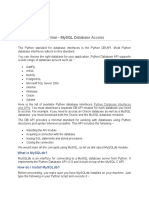0% found this document useful (0 votes)
7 views2 pagesPython SQL Interface
The document outlines how to interface Python with MySQL to perform operations on an 'EMPLOYEE' table in a 'BANK' database. It includes code snippets for displaying male staff names, inserting new employee data, updating salaries for the accounts department, and deleting records of employees with salaries below 20,000. Each operation demonstrates the use of the mysql.connector library for database connectivity and manipulation.
Uploaded by
rushda.7369Copyright
© © All Rights Reserved
We take content rights seriously. If you suspect this is your content, claim it here.
Available Formats
Download as PDF, TXT or read online on Scribd
0% found this document useful (0 votes)
7 views2 pagesPython SQL Interface
The document outlines how to interface Python with MySQL to perform operations on an 'EMPLOYEE' table in a 'BANK' database. It includes code snippets for displaying male staff names, inserting new employee data, updating salaries for the accounts department, and deleting records of employees with salaries below 20,000. Each operation demonstrates the use of the mysql.connector library for database connectivity and manipulation.
Uploaded by
rushda.7369Copyright
© © All Rights Reserved
We take content rights seriously. If you suspect this is your content, claim it here.
Available Formats
Download as PDF, TXT or read online on Scribd
/ 2

































































